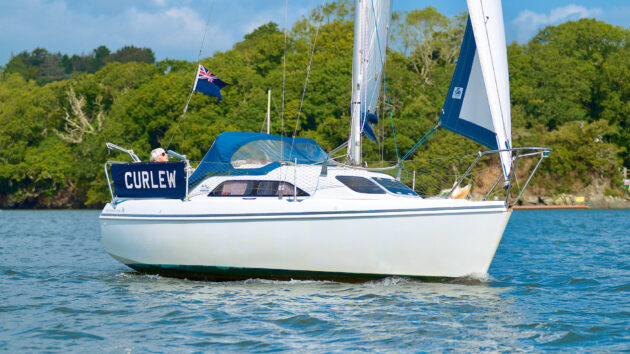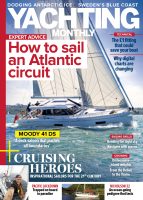She may be small but the Hunter Ranger 245 crams in both a staggering amount of accommodation and a healthy dose of sailing enjoyment, says Nic Compton
Hunter Ranger 245 used boat review: Small but mighty
You can’t miss Peter Waite’s boat Curlew. As you come out of the Stoke Gabriel estuary on the River Dart, she’s the first yacht you meet on the line of deep(er) moorings that run up and down the river proper.
This means the Hunter Ranger 245 is visible from Peter’s house in the village but it also means some newbie sailors literally can’t miss her, and on at least one occasion, Peter has had to fix a rather nasty ding in the topsides where a dinghy has rammed into the boat.
I used to keep my Victoria 26 about four moorings up from Curlew – safely out of the line of fire – and she always struck me as a bold-looking boat with a purposeful air. We loved our Victoria 26, but with her slim hull and limited accommodation, she was a tad small for a family of four. When Peter told me his boat had six berths and yet was 1ft 6in shorter than ours, I did a double-take and looked at her with new respect.
Five years later, I finally found myself on board and admiring that vast interior. It really is quite impressive how much the builders managed to pack in such a small space – albeit it is all open plan, apart from the toilet.
There’s that double bunk forward, with two large windows and a hatch overhead, which I could imagine would be a great place for the kids to hang out. There’s the huge U-shaped settee itself set around a central table, which would be brilliant for convivial family meals, or playing Monopoly with the kids, or late-night drinking – depending on your stage of life.

For Nic’s second sail aboard, Peter had moved the mainsheet to the bridge deck, to make uncleating the mainsheet easier. Photo: Nic Compton
On the port side there’s a dinky fold-up chart table, not huge but big enough for a folded-up chart – though I’m guessing that corner could catch you in the gut in rough weather. Aft of that is the heads, which may not be the biggest but is at least enclosed.
On the starboard side amidships, there’s a nicely-built compact galley, with rounded wooden grabrails around an oval sink, a coolbox under the side deck and a two-ring cooker to one side. Aft of that is a double berth, which tucks in under the cockpit floor, behind the engine compartment, though for some it might be a tad claustrophobic.
Article continues below…
All this space matters to Peter, who wanted a boat on which he could host his five children and step-children and eight grandchildren – though not necessarily all at once.
‘I wanted something I could manage on my own but could take some of the family with me,’ he says. ‘Also I’ve got a very tall son-in-law, and this boat has massive headroom, over 6ft. I looked at other boats, such as Sadlers, but I wanted something the children would feel safe in, so I didn’t want a Folkboat-style low freeboard. I like the higher freeboard of this boat.’

The self-tacking jib is easy to handle if a little underpowered. Photo: Nic Compton
A boat of his own
Peter grew up sailing dinghies, first on an Enterprise on Yeadon dam in Yorkshire, followed by a Fireball at the Chew Valley Sailing Club near Bristol, and then a Laser 2 on a gravel pit near Reading.
He was one of the first people to sail on the sail training ship Sir Winston Churchill in April 1966, and was first mate on a charter yacht based in Salcombe, Devon, for several years. He studied maths at Oxford University because, he says, ‘I wanted to understand how tides and currents worked, having struggled with the tides around the Salcombe estuary.’

The self-tacking jib track takes up a fair bit of space on deck but keeps handling simple. Photo: Nic Compton
He and his wife Pip bought a house in Stoke Gabriel in 2012 and bought a 12ft Comet to keep on the foreshore near their house. Pip eventually agreed to buying a bigger boat on condition that they could have a set of bifold windows fitted to the front of their house. The budget was therefore set at around the £20,000 mark.
The Ranger 245 was designed in 1996 by David Thomas (prolific designer of Sigmas, Elizabethans and Impalas, among others) as a follow-up to the Ranger 265, and is considered by some to perform better than her bigger sister. Unlike previous boats in the Hunter range, the Rangers were designed as all-out cruisers and never intended to race. The idea was always to produce a comfortable family boat that packed a lot of punch, and yet sailed reasonably well.

Dinghy davits might not be common on a boat of this size, but for coastal pottering they make launching and recovering a tender a doddle. Photo: Nic Compton
The Ranger 265 and 245 were among the first cruising yachts to sport the now-ubiquitous chine aft, to increase buoyancy and improve their directional stability. They were available with either a fin keel (draught 4ft 9in/1.47m) or twin keel (draught 3ft/0.97m) though, unlike previous bilge keels, the new Hunter keels were aerofoil section with bulbs at the bottom of each keel to lower the centre of gravity. The result was better performance and a stiffer ride than the previous generation of bilge keelers – though not as fast as a fin keeler.
After being bought by Select Yachts (owners of the Cornish Crabber range) in the early 2000s, the Ranger 245 was then acquired by Lauren Marine in 2006 and relaunched as the Channel 245, with slightly different windows but other than that, essentially the same boat.

Lines are led aft to either side of a good big companionway. Photo: Nic Compton
The Ranger 245 is sometimes described as a ‘stepping stone’ from dinghy sailing to owning a fully-fledged long-distance cruising yacht, and indeed Peter confesses that his ‘dream boat’ would be a long-keeled traditional yacht such a Nicholson 32. That said, his actual cruising range – from Torquay in the east to Newton Ferrers in the west – suggests that the Ranger 245 suits him remarkably well.
A good support network
‘I wanted something I could poke into an estuary, having sailed a 33-footer around Devon and Cornwall – there were times when it felt like we were pushing it a bit and that we could easily get stuck. Another consideration was the ability to sail single-handed, and the self-tacking jib makes this boat very easy to sail. When I’ve got crew on board, we can make things more exciting by hoisting the asymmetric spinnaker.’

High topsides and a large coachroof may look a little boxy, but they ensure lots of volume below. Photo: Nic Compton
Peter also noted that there was an active Hunter owners’ association, with an online forum advising on how to make specific modifications, such as fitting a holding tank, which he felt might provide a good support network. Several boats were available in the southwest area where he lives, so he had a fair amount of choice – something that still appears to be the case, with several Ranger 245s for sale in various parts of the UK. In other words, they’re not hard to come by, which means they sell at an affordable price for such a relatively new boat.
Some Ranger 245s were originally available part-finished, with the buyers doing the interior fit-out themselves, which means the standard of accommodation can be variable – something to look out for when buying. Peter’s boat was built in 1998 and fitted out by the yard to a good, solid standard, so he has no worries on that front.
The original boats also had an option for an outboard, but Peter’s version has an inboard engine – a 10hp Yanmar with excellent fore and aft access – leaving room for an enormous cockpit locker on the port side, where the outboard would have been.

U-shaped seating around the saloon table works well, with a V-berth forward – curtains for privacy could be added. Photo: Nic Compton
Peter’s mods
Peter has made a few small yet significant modifications since he bought the boat. Bizarrely, the boat was not fitted with a bilge pump, so that was top of the list of basic safety items, along with jackstays to clip safety lines onto. Likewise the navigation lights were extremely basic: just a tricolour and an all-round white. Someone had added port and starboard lights on the pulpit, but no white lights, so Peter added the necessary bow and stern lights.
The previous owner had fitted a pair of davits, which might sound crazy on such a small boat but, as I know from personal experience on my boat (a Freedom 33 fitted with davits), they are remarkably useful.

Not many boat this size have a proper little chart table like this. It can be folded away when needed. Photo: Nic Compton
On longer passages, it’s so much easier to hoist the dinghy on davits than deflate it and pack it away every time, not to mention taking up valuable storage space and/or blocking the view. Peter kept the davits but replaced the wooden bases, which had deteriorated, with new blocks of laminated hardwood.
Peter’s main alteration, however, was to have all the old antifouling paint stripped off and to repaint the bottom with Coppercoat. He and Pip painted on the five coats themselves, although they had the keels, which were showing some signs of rust coming through, redone professionally the next year.

Cosy for a double, but two could squeeze in the aft berth if needed. Photo: Nic Compton
Eight years on, he’s delighted with the results, and reckons it’s cheaper than conventional antifouling in the long run, as well as being much better for the environment. That said, by the time I sailed on board the boat in September, her bottom hadn’t been scrubbed since June and sported a layer of barnacles, which clearly affected her performance – so much so that we decided to reschedule a second sail a few weeks later, once her bottom had been cleaned, to give her a fair chance.
Stable sailing
Stepping on board for that first sail, my first impression was how stable she felt, giving the feel of a much bigger boat. Thanks to those barnacles, however, she felt sluggish under sail, until Peter hoisted the asymmetric spinnaker, and suddenly she came alive and flew down the river towards Dittisham – so much so that we were almost there by the time we’d sorted out the various sheeting niggles.
More worrying, perhaps, was the boat’s weather helm, which was unremarkable until we were hit by a sudden gust and she rounded up into the wind, almost completely losing steerage and narrowly missing a boat on a mooring in the process. Elsewhere, I read the boat has a tendency to broach and to be ready to dump the mainsail as soon as that happened – but with the mainsheet jammer located low to the cockpit floor that was hard to do with any speed.

Curlew’s remarkable 3ft draught makes exploring shallow creeks a possibility. Photo: Nic Compton
Afterwards, I was reassured to read several reviews which raved about the boat’s performance. One owner on an online forum describes the Ranger 245 as a ‘bionic boat – especially upwind in a bit of breeze’. Elsewhere someone who had owned one for seven years and cruised it extensively up and down the Channel, including trips to France and Belgium, said his boat needed a Force 4 to really get going and suggested her average cruising speed was 3.5 knots.
We headed out to sea to get some clear air for our second sail, which also gave me a chance to try the boat under engine as we motored down the Dart. I found her agile and responsive, though she needed constant attention in order to keep her in a straight line – making an autopilot a necessity for long passages, but suggesting she would be easy to manoeuvre in a harbour.
A Force 3-5 south-easterly was blowing that day – a perfect sailing breeze, apart from the huge swell that builds up at the entrance to the Dart on an ebbing tide.

Aft hull chines, almost ubiquitous these days, were pretty novel in the mid 1990s. Photo: Nic Compton
We had an extremely uncomfortable 15 minutes motoring out of the estuary – yet, ironically, it was here that I felt the boat performed her best. Bearing in mind she’s only 24ft 6in long, she coped with the waves remarkably well and never felt out of control or remotely dangerous. I could imagine if you had to do this with the family on board, they might feel uncomfortable but not scared.
Under sail, Curlew definitely enjoyed the stronger breeze, clocking up to 4.4 knots beating into the wind (not a bad speed considering the conditions) and 5.7 knots (SOG) on a reach.
Peter has some issues with friction in the running rigging which makes the sails troublesome to set, but once we had heaved and pulled it all into place, the rig felt snug and efficient. With two reefs in the main and the small self-tacking jib set, she coped easily with the uncomfortable conditions we encountered.
Hunter Ranger 245 specifications
DESIGNER: David Thomas
YEARS BUILT: 1997-
LOA: 24ft 6in / 7.47m
LWL: 21ft / 6.4m
BEAM: 8ft 9in / 2.67m
DRAUGHT: 3ft 1in / 0.94m (twin); 4ft 6in / 1.37m (fin)
DISPLACEMENT: 4945lbs / 2248kg (twin)
BALLAST: 1978 lbs / 897kg
SAIL AREA: 245 sq ft / 22.76m2
PRICE: £10,000-£22,000
Enjoyed reading this?
A subscription to Yachting Monthly magazine costs around 40% less than the cover price, so you can save money compared to buying single issues.
Print and digital editions are available through Magazines Direct – where you can also find the latest deals.
YM is packed with information to help you get the most from your time on the water.
-
-
- Take your seamanship to the next level with tips, advice and skills from our experts
- Impartial in-depth reviews of the latest yachts and equipment
- Cruising guides to help you reach those dream destinations
-
Follow us on Facebook, Twitter and Instagram.
Verdict
You have to love a boat that packs in six berths, a chart table, a galley and an enclosed heads into a 24ft 6in hull. Inevitably, the design errs towards the tubby rather than the sleek, but it does so in a likeable way. All boats are compromises and you simply can’t pack that much accommodation into a boat and end up with a dainty damsel. You pays your money and you takes your choice, as the saying goes. Where the Ranger 245 clearly does excel is for the type of cruising that Peter bought his boat for: pottering up and down the estuary with a gang of children of board; anchoring off nearby beaches – and occasionally heading off on longer trips on his own. You might not want to cross an ocean on this boat, but she clearly has a place for the more modest cruising that most of us end up doing in real life. Peter has had some good times on his pocket cruiser, including clocking up 6.9 knots sailing across Torbay in a Force 5, with just the staysail set and a reef in the main to keep the boat stable. Other highlights include frolicking with dolphins on Start Bay, anchoring off Blackpool Sands and going swimming with the family, and creeping up Frogmore Creek near Salcombe, making the most of the boat’s astonishing 3ft draught to explore where few other yachts of this size dare to go. Peter has made some precious memories aboard Curlew, which is surely what sailing your own boat is all about.





